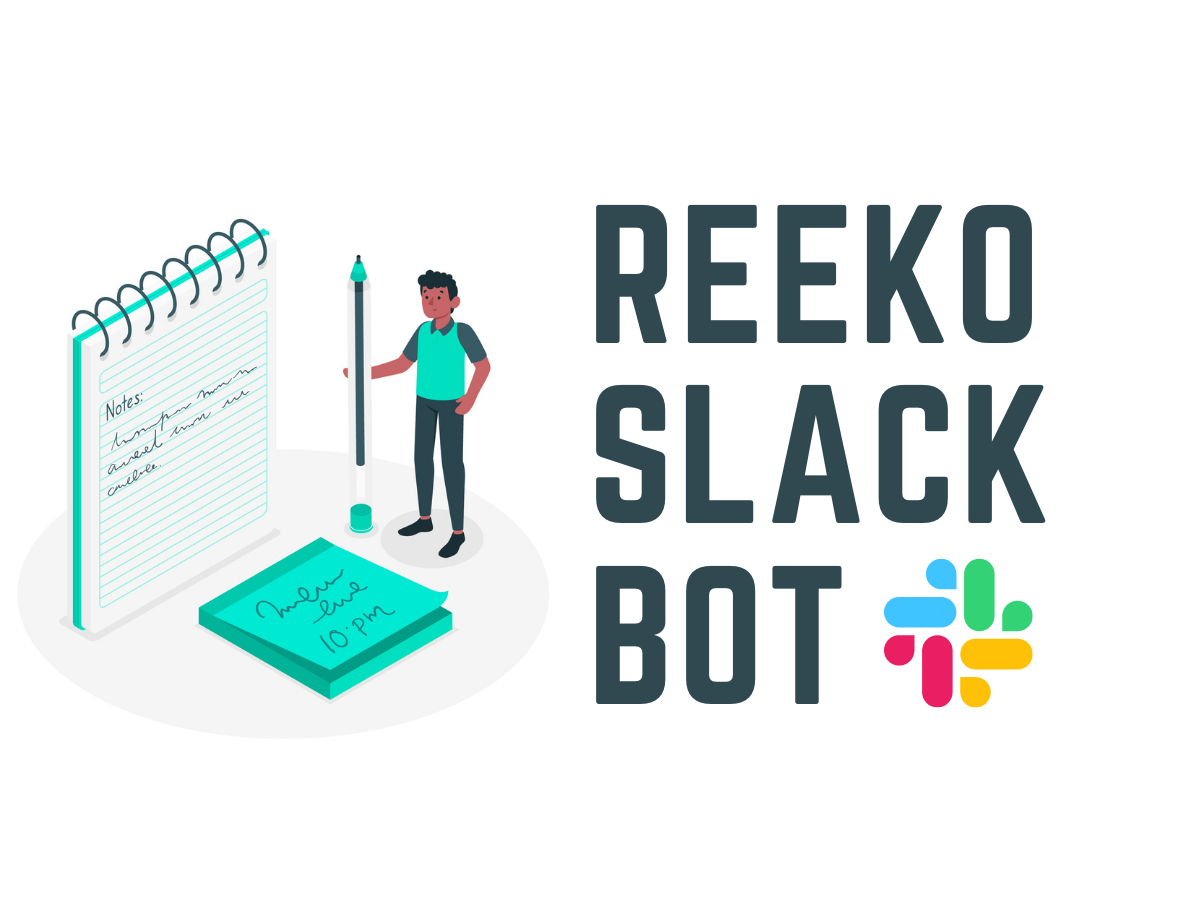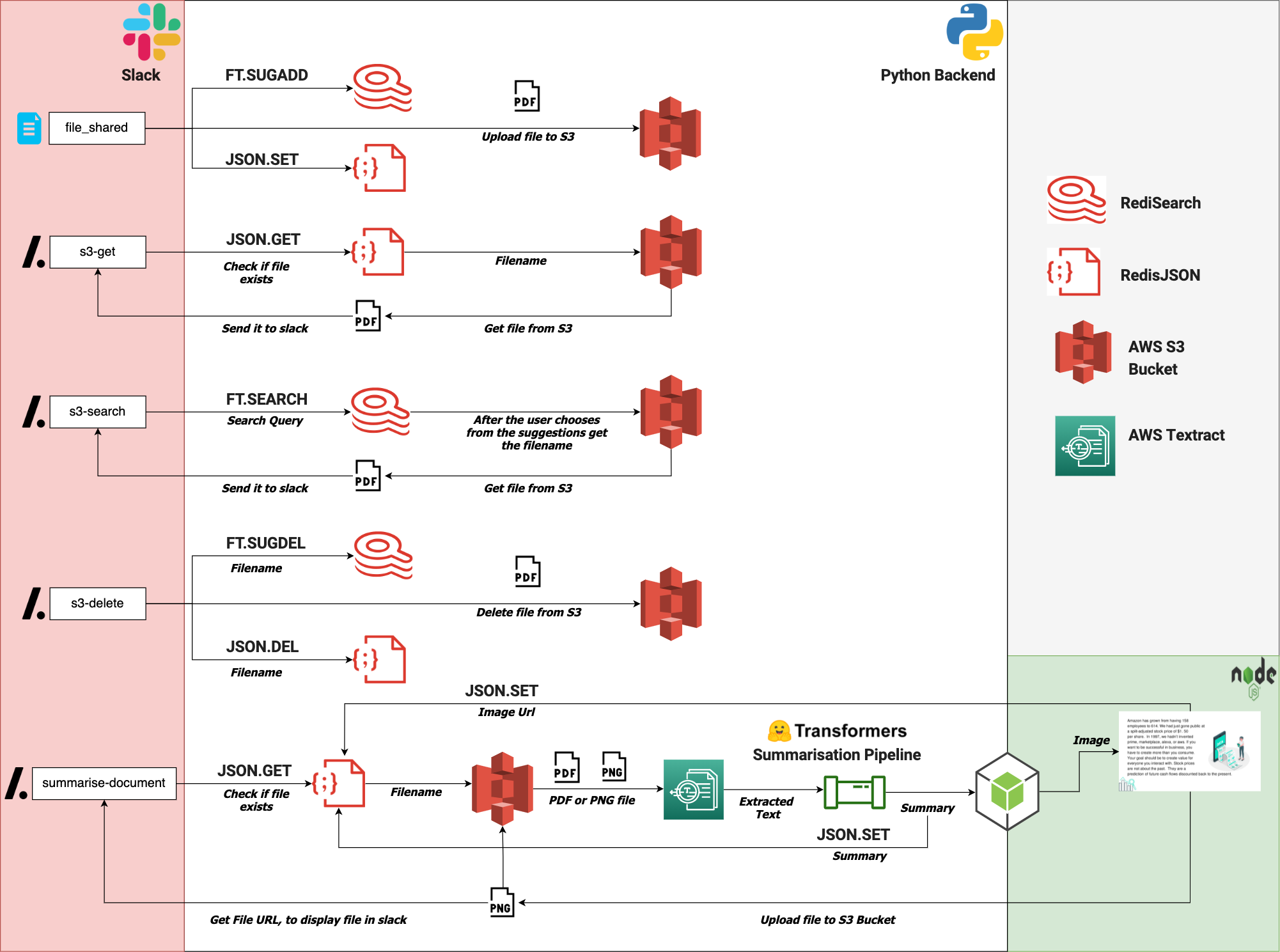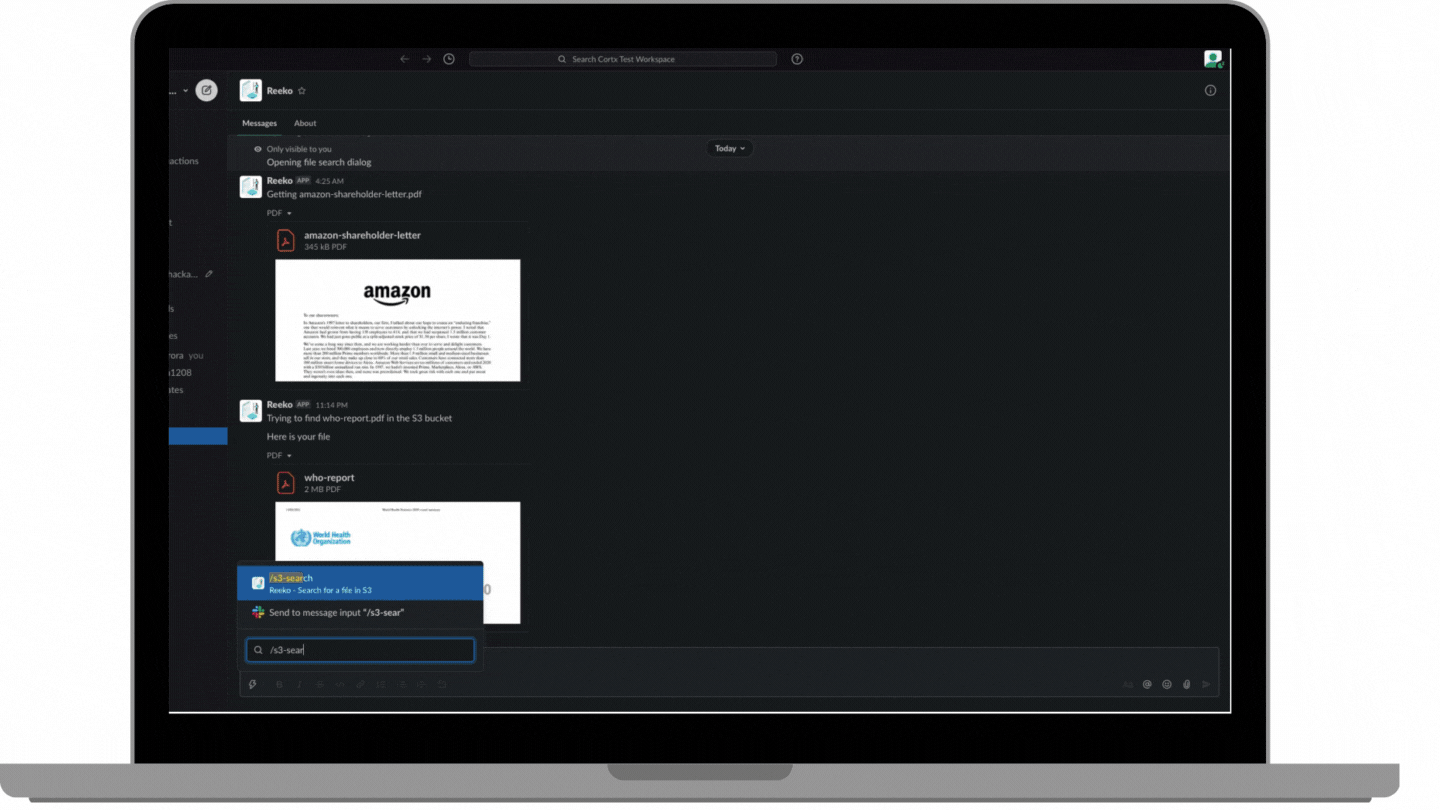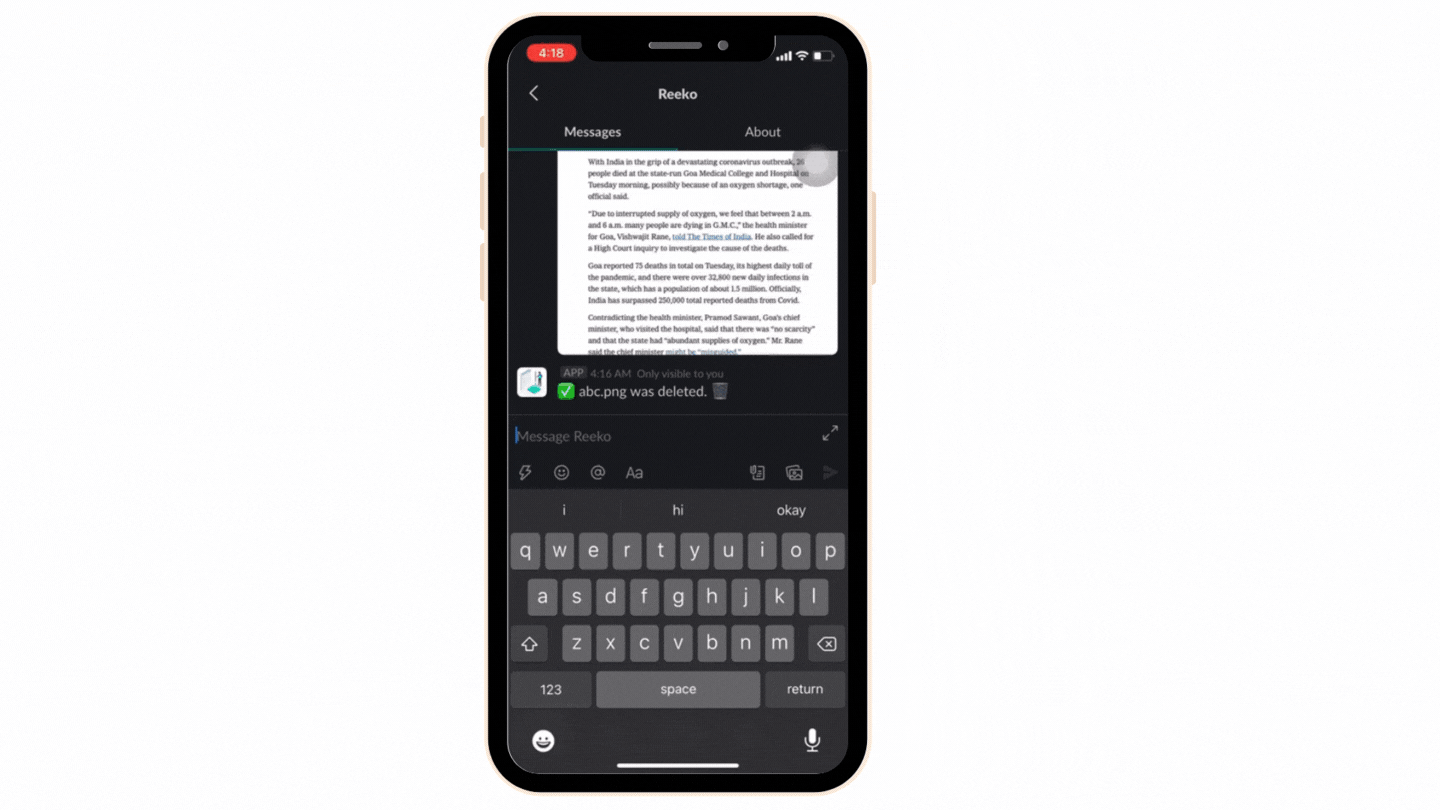With 10+ million daily active users and millions of file shared everyday, Slack is where collaboration happens. Using Reeko you can find files, download them or delete them permanently from S3 bucket without leaving Slack or writing a single line of code. Everyday so many files are shared on Slack and we may lose track of the file we need. Using advanced Natural Language Processing (NLP) and Natural Language Understanding (NLU) techniques, Reeko extracts all the text from the long and boring documents and outputs the summary as an image. This way you don't even have to open the document to know what is inside of it!. Most of the time we don't know the exact name of the file we are looking for and we need autocomplete to figure out the exact file name for us. Reeko has a file search engine built right into Slack that helps you find any file on your S3 bucket.
Document Summarization is the task of rewriting a document into its shorter form while still retaining its important content. With the help of the /summarise-document filename you can summarise any document. Everything from minutes of the meeting to UNICEF can be shortened.
Reeko Slack Bot enables users to access files in your S3 bucket directly from Slack using Slash commands. By using simple commands like /s3-get filename and /s3-delete filename we can find or delete files. Whenever a new file is shared on any public channel it is automatically added to the S3 test bucket, ensuring that all your slack files are safe in case a teammate accidently deletes a file that you need.
Most of the time we don't know the exact name of the file we are looking for. We also need to check if the file is actually present in the S3 bucket. Pooling the bucket over and over again to find a file or check for its existence is a computationally expensive and slow operation. To enable faster indexing of all the files on the S3 bucket, there is a layer ofRedis Searchbetween the Slack Bot and the S3 bucket. A user can find any file using the /s3-search command which opens a file search dialog. Redis Search's autocomplete functionality helps in navigating or guiding the user by prompting them with likely completions and alternatives to the filenames as they are typing in.
- Slack Block Kit: A UI framework for Slack apps that offers a balance of control and flexibility when building experiences.
- Python: The [redisjson-py](https://github.com/Redis JSON/redisjson-py) and redisearch-py libraries are used to connect to Redis and Slack Bolt For Python is a foundational framework that we have used to handle the requests from the Slack Workspace.
- Nodejs: Responsible for Image Generation
The Slack app is built using Bolt for Python framework. For connecting to the AWS S3 bucket and AWS Textract we use their respective boto3 clients.
The Slack app listens to all sorts of events happening around your workspace — messages being posted, files being shared, users joining the team, and more. To listen for events, the slack app uses the Events API. To enable custom interactivity like the search modal we use the Blocks Kit.
Slash commands perform a very simple task: they take whatever text you enter after the command itself (along with some other predefined values), send it to a URL, then accept whatever the script returns and posts it as a Slackbot message to the person who issued the command or in a public channel. We have a set of 4 slash commands that make our slackbot.
We have used 2 Redis Modules.
- Redis JSON - For storing file information like filename, summary and image url.
- Redis Search - For searching files in the S3 bucket
InitialisingRedis Searchin redisearch_connector.py. Creating an index with the name file_index.
fromRedis Searchimport Client, TextField, AutoCompleter, Suggestion
class Redis SearchConnector():
def __init__(self):
self.index_name = 'file_index'
self.client = Client(self.index_name)
self.ac = AutoCompleter(self.index_name)Initialising Redis JSON in redisjson_connector.py
from rejson import Client, Path
class RedisJsonConnector():
def __init__(self):
self.rj = Client(decode_responses=True)Creating an index on Redis Search
FT.CREATE file-index ON HASH SCHEMA file_name TEXT SORTABLE file_id TEXT created TEXT timestamp TEXT mimetype TEXT filetype TEXT user_id TEXT sizeWhenever a new file is shared in any public slack channel the file_share event is sent to the Slack Bolt app. Firstly the file name is added as suggestion using the FT.SUGADD command in Redis Search, the file data like name, created, timestamp, mimetype, filetype, size, summary and image file path are added using the JSON.SET command.
The file is then stored on the S3 bucket as an object with the key as the filename.
FT.SUGADD file-index "amazon-shareholder-letter.pdf" 1JSON.SET amazonshareholderletterpdf . '{"file_id": "F022ACR81HP", "file_name": "amazonshareholderletterpdf", "created": "1620994889", "timestamp": "1620994889", "mimetype": "application/pdf", "filetype": "pdf", "user_id": "U01U4DV4C8J", "size": "345142", "summary": "", "image_file_path": ""}'After fetching the filename from the command["text"] parameter we check if the document exists. If the document doesn’t exist it returns false and nothing is done. If the file is found, using the JSON.GET command we get the file’s name and then download it from the S3 bucket. The downloaded file is sent back as a direct message in Slack.
JSON.GET amazonshareholderletterpdfThis command permanently deletes a file from the S3 bucket. All you have to do is get the filename from command["text'] parameter. The file data is deleted from RedisJson using the JSON.DEL command and it is removed from Redis Search's suggestions using the FT.SUGDEL command. Users are informed once the file is successfully deleted
FT.SUGDEL file-index "amazon-shareholder-letter.pdf"JSON.DEL amazonshareholderletterpdfThis command opens up a modal inside of Slack with a search bar, the user is suggested the file names depending on whatever text is written in. For example if the bucket has documents like abc.csv, abcd.csv, abcdef.csv upon typing abc we get will get these 3 results as a list from the FT.SEARCH command. After the user chooses one of the file from the suggestion the file is downloaded and sent back to slack.
FT.SEARCH file-index "ama"Using the summarise document command large documents can be converted into images
- Get the file name from the command['text'] parameter.
- If the file is found, using the
JSON.GETcommand we get the file's name.
JSON.GET amazonshareholderletterpdf- Download the pdf or png file locally from S3 bucket
- Extract the text using AWS Textract.
- The extracted text is summarised using Hugging face transformers summarisation pipeline. The text summary is also added back to the JSON document using
JSON.SETcommand.
JSON.SET amazonshareholderletterpdf .summary ' Amazon has grown from having 158 employees to 614. We had just gone public at a split-adjusted stock price of $1. 50 per share. In 1997, we hadnâ\x80\x99t invented prime, marketplace, alexa, or aws. If you want to be successful in business, you have to create more than you consume. Your goal should be to create value for everyone you interact with. Stock prices are not about the past. They are a prediction of future cash flows discounted back to the present.'- A post request is then sent to the /create-image on the nodejs backend with the file name and summary text.
- An image is generated using a base template
- The image that is returned is saved to the S3 bucket and sent back to Slack.
- The image URL is also added to the JSON document using
JSON.SETcommand.
JSON.SET amazonshareholderletterpdf .file_path 'https://bucket-1234.s3.amazonaws.com/b8bac45f-7f69-4c28-a26e-9888d9771bed-image.png'Here is the document summary for the Amazon 2020 shareholder letter
Redismod - a Docker image with select Redis modules
docker pull redislabs/redismod
docker run -p 6379:6379 redislabs/redismodTo get the Bolt app running locally follow the instructions at python-backend/README.md
To get the Nodejs server running locally follow the instructions at nodejs-backend/README.md






















